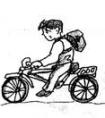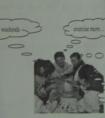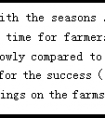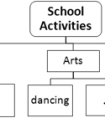We are always using body language in our daily life.When we have a conversation with someone,we may be using more body language than words.However,the same bod-英语
题文
| We are always using body language in our daily life.When we have a conversation with someone,we may be using more body language than words.However,the same body language may mean different things in different countries.That’s why people sometimes do not understand each other correctly.Pointing to one part of the body can mean differently in different cultures. For example,in the U.S.A.people point to their heads when they think someone is clever.However,in Europe it means“He or she is stupid or something is wrong with his or her head.” In our Chinese culture,nodding our head up and down means“yes”and shaking our head from side to side means“no”.However,in parts of India,Greece and Turkey,it means just the opposite. In England or the U.S.A.,when you raise your hand and make a circle with the thumb(拇指)and the second finger,it means“You’re all right or everything is OK.”However,if we do this in France or Belgium,it means“You’re worth zero.”In Greece or Turkey,we should not make this gesture,or we will be thought to be very rude. The meaning of gestures can also change over time.In the 1960s,the V sign meant“peace”.However,during World War Ⅱ,it meant“victory”.In Greece,it is a very insulting (污辱性)sign. Though the meaning of body language is different, there are some expressions having the same meaning all over the world, such as smiling and crying. 根据短文内容.用简洁的句子或短语完成下列表格。
| |||||||||||||||||||||||
答案
| 小题1: In parts of India, Greece and Turkey 小题2:Your’re all right or everything is OK. 小题3:In the 1960s 小题4:smiling and crying |
| 小题1:通过However,in parts of India,Greece and Turkey,it means just The opposite.这一句可以判断 In parts of India, Greece and Turkey 点头表示不的意思。 小题2:通过In England or the U.S.A.,when you raise your hand and make a circle with the thumb(拇指)and the second finger,it means“You’re all right or everything is OK.”这一句可以判断在英国或美国,把拇 指和食指放在一起构成一个圈表示你一切都好的意思。 小题3:通过 In the 1960s,the V sign meant“peace”.这一句可以判断V符 号在美国20世纪60年代表示和平的意思。 小题4:通过Though the meaning of body language is different, there are Some expressions having the same meaning all over the world, such as smiling and crying.这一句可以判断在全世界一些表达用语所表示 的意思是一样的,诸如微笑和哭。 |
据专家权威分析,试题“We are always using body language in our daily life.When we ..”主要考查你对 问答题 等考点的理解。关于这些考点的“档案”如下:
问答题
考点名称:问答题
- 问答题:
主要是根据前提问题来做出相应的要求内的答案,题型比较灵活但是考查了学生多方面的知识和技能。 - 要做好这类题,就要注意平时知识的积累,包括单词、词组、句型等。
- 最新内容
- 相关内容
- 网友推荐
- 图文推荐
上一篇:任务型阅读:阅读文章,根据文章内容填写表格。(每空一词,共10分)Zhalong is a nature reserve in Heilongjiang in northeast China. It is one of the world’s most impo-八年级英语
下一篇:Just as in face-to-face communication, there are some basic rules of behavior that should be followed on the Internet. The basic rule is simple: treat others in-英语
零零教育社区:论坛热帖子
| [家长教育] 孩子为什么会和父母感情疏离? (2019-07-14) |
| [教师分享] 给远方姐姐的一封信 (2018-11-07) |
| [教师分享] 伸缩门 (2018-11-07) |
| [教师分享] 回家乡 (2018-11-07) |
| [教师分享] 是风味也是人间 (2018-11-07) |
| [教师分享] 一句格言的启示 (2018-11-07) |
| [教师分享] 无规矩不成方圆 (2018-11-07) |
| [教师分享] 第十届全国教育名家论坛有感(二) (2018-11-07) |
| [教师分享] 贪玩的小狗 (2018-11-07) |
| [教师分享] 未命名文章 (2018-11-07) |






